Acoustical comparison of the Hammered Dulcimer
Often musical instrument makers, like Herbert Rust a styrian dulcimer maker, need to compare instruments in terms of sound quality. In addition to the sound spectrum of the produced tone, the decay time of the excited note is also a main quality parameter for the hammered dulcimer.
he research was started by Herbert Rust and holder of the "FFG Innovationsscheck". The main aspects of this research was to provide a methode for a objective comparison of the decay times of the hammered dulcimer. This comparison should lead to a steady improvement and optimization of the building prozess. On the other hand objective measurements could help customers in their buying decisions.
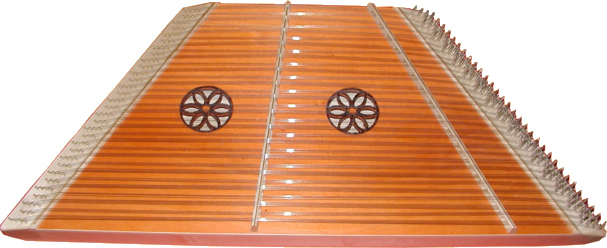
Fig. 1: Styrian Dulcimer
Benefit and results of this research project
On the one hand this Project lead an Instrumentmaker to use modern research methodes and helped also the holder to be voted of one of the most innovative small-busines enterpriser of Styria in the year 2010. On the the other hand further research and development have been presented on international conferences on music acoustics (download as pdf).
Overview of Research
In general, the Styrian Dulcimer (see Fig. 1) is played using a special set of drumstick or hammer (see Fig 2). Mostly the heads of the wooden hammers have one side covered with leather (or similar material) to soften the surface. This gives the musician the possibility to change the characteristic of the produced sound.
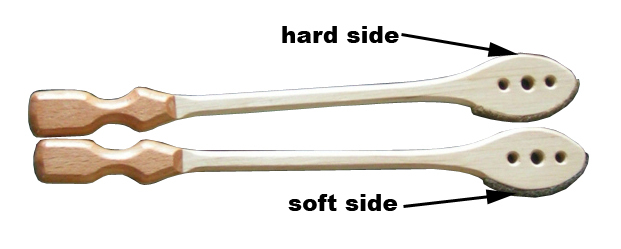 |
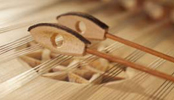 |
For comparing the sound and decay rate of the initiated note, the excitation has to be as reproducible as possible. In fact, a musician will not be able to strike the hammer in the exact same way. Fig. 3 illustrates the main parameters.
| φ | angle of strike |
| α | the possible tilt in the rotation of the beater |
| β | is the variance of the hammer angle different from 90 degrees in relation to the strings |
| XPos | defines the variety in the distance measured between beater and bridge |
| YPos | is the strike position in relation to the center of the set of strings |
| F | striking force |
| v | striking velocity |
According to the aforementioned possible variations of striking parameters, an electro mechanical system to provide reproducibility has been designed. The artificial excitation mechanism (AEM) consists of two solenoids connected to a hammer fixture and a computer interface. Software controls the audio recording, as well the movement of the hammer.
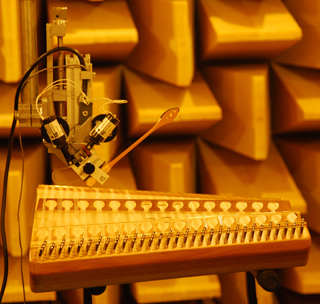 |
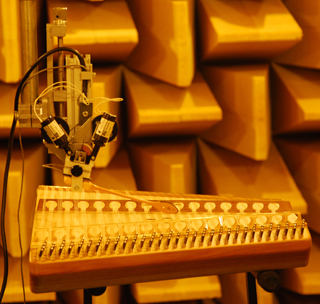 |
| Fig. 4: AEM ready for a strike |
Fig. 5: AEM at the moment of strike
|
Figuer 4 and 5 show the striking event. By activating the right side solenoid in Fig. 6 the beater moves downward. As soon as the hammer-head touches the string a force sensor, located between the beater and the fixture, sends a signal to a control-box. This signal switches the right side solenoid off and activates the left side solenoid to pull the hammer back to its starting position. This provides, on the one hand a free vibration of the string and on the other hand a non chattering excitation.

Fig. 6: The mechanical excitation mechanism
Conclusions
After using the AEM the excitation was proved to be reproducible by recording 10 excitations at 3 notes each, and comparing the sound-data. The differences in sound-level are below 1 dB, a comparison of the sound spectra show negligible variations. This highly reproducible sound-production simplifies the calculation of the decay time. The artificial excitation mechanism proved to excite the instrument more consistently (therefore more reproducibly) than a musician. The standard deviation of the measured decay rates of 5 human excitations (1,23) in comparison to 5 computer controlled excitations (0,12) showed a factor of about 10 in difference (see Fig. 7).
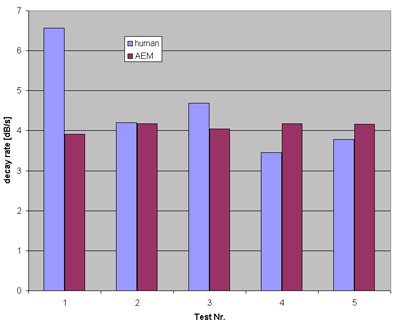
Due to thermal effects inside the solenoids and electronics, some variances in the striking force are not negligible. The accuracy of the AEM could be improved by using the force sensor not only as a trigger, but also to normalize the recorded sound signal by the measured striking force.